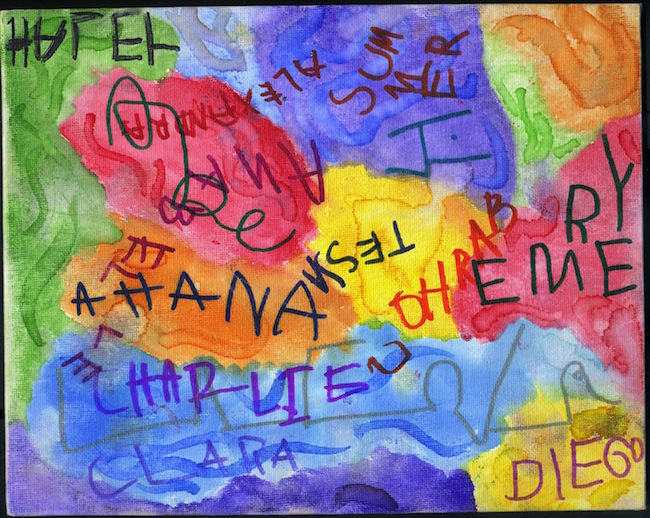Fine art by four year olds
Boundless Expression

I have collaborated with two art classes of four and five year-old students from the nursery school where I work as a substitute teacher. First, students in one class signed their names wherever they wanted on the canvas with sharpie markers of their choice. The lead teacher Jim and I also signed the canvass in ways that we felt embodied the experience—jovially. Then I applied a wash of watercolors. Finally, the second class wrote their signatures, and happened to leave some finger/handprints as well.
The nature of the translation embodied by this project may be viewed in a number of ways: Firstly, I feel that I have rendered the overall experience of facilitating these classes into a multimedia painting. The colorful and whimsical nature of the composition is very much reminiscent of the class itself. As a teacher, each student leaves a unique impression on me. I feel that their signatures tend to embody their personalities. This painting also brings up the notion of calligraphy—writing that is both a form of written and visual artwork. However, the calligraphers with whom I have worked are almost entirely untrained. The question arises as to what extent we really improve as we are trained and train ourselves to write and draw just like everyone else.
These kids are just beginning to write. Writing by its nature is an exercise in translating thought into written words. These students are not yet completely familiar with the conventions of writing. They have not yet come to terms with the idea that they must string letters along in the form of words the same way every time. Some of the students only write backwards. Others seemingly disregard the order and arrangement of their letters. When I asked one student why he didn’t spell his name properly, he replied matter-of-factly, “sometimes I like to write it differently.” Given that these outsider artists have had basically no experience with the mainstream art world, and the fact that their process has not yet been inhibited by training and practice, the artistic liberty that they display is perhaps the freest form of expression that I have ever encountered.